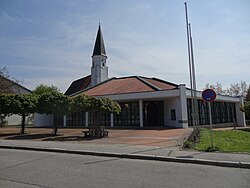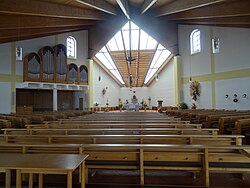St. Nikola (Altdorf)
The Roman Catholic side church St. Nikola (also St. Nikolaus , formerly St. Stephanus ) in Altdorf near Landshut in Lower Bavaria is a late Gothic church, which was drastically enlarged in 1982 with the addition of an independent modern church. Today Neu-St. Nikola, due to its size and its central location in the town center, can be regarded as the main church of the Altdorf market, although under canon law it is only a subsidiary church of the parish of the Visitation of Mary . The church was originally consecrated to St. Stephen until the patronage changed to St. Nicholas of Myra in 1710 (memorial day: December 6th).
Alt-St. Nikola
history
After Altdorf was Christianized by Benedictine monks from Regensburg as early as the second half of the 7th century , a first wooden baptismal church was built around 750 on the site where the Alt-St. Nikola is located. This first church in Altdorf was probably destroyed again in 909 during the Hungarian invasions . The current building was built around 1480 by an unknown builder. It could, however, be Peter Westermeier, who also built the church in Gisseltshausen near Rottenburg . Major structural repairs were carried out in 1620 by Christoph Stelzer and in 1656 by Wolf Redenpeckh, both builders from Landshut. The latter drew on square pillars resting western gallery one. In the period that followed, the originally Gothic interior was gradually changed to Baroque style . The year 1719 can be found at one point in the pavement , which could be an indication of major renovation work at that time.
architecture
The house of God is a five-bay , plastered hall building made of brick , which ends in three octagonal sides to the east. The choir has not been eliminated. The outer structure is structured by two separate buttresses , with the upper ledge positioned over a corner. In addition, the building has a surrounding roof frieze . The window openings should originally have been made with a pointed arch , but were changed to have a rounded arch in the Baroque period .
The tower stands to the west of the nave exactly on its central axis. The two-storey substructure with a square floor plan is enlivened by pointed arches on the upper storey. The transition to the octagonal superstructure is provided by corner and central struts, some of which are set off several times. The sound opening at the upper end of the octagonal attachment is made in an ogival shape, the sound opening has been made smaller and now closes with a round arch to make space for the only tower clock . The pointed, late Gothic stone helmet has been preserved to this day, but was clad with copper sheet .
The ogival portal is on the south side in the second yoke from the west. The wall is profiled with two round bars between covings . The interior is vaulted by a needle cap barrel. The pointed arches arise from chamfered pilasters , the bevels of which are profiled with a round rod between covings. The pilasters are presented with circular services that originally served to hold the vault ribs. However, these were knocked off in the early 20th century; only a star vault remained in the sacristy . Its pear-shaped ribs arise from simple pointed consoles . In the rear nave yoke, a vaulted gallery was inserted on square pillars during the baroque renovation .
Furnishing
The baroque, two-column high altar dates from around 1670. It contains an altarpiece rich in figures of the coronation of Mary and - below carved volutes - the side figures of St. Nicholas (left) and St. Stephen (right) by the Landshut sculptor Jonas Hiernle. The two side altars from around 1740 are designed in the early Rococo style. The southern (right) side altar shows a figure of St. Sebastian by the Landshut sculptor Anton Hiernle. The north (left) side altar contains what is probably the most valuable piece of furniture from the old Nikolakirche, a figure of the Madonna with baby Jesus by the sculptor Hans Krumpper from Weilheim . This was stored for a long time and only found its place on the left side altar in the early 1930s.
The pulpit with a polygonal body from around 1720 is structured by ribbons and winding corner pillars. In the niches in between there are small figures of the four evangelists . The pulpit is decorated with rich acanthus carvings. Like the pulpit, all of the church stalls , including the choir stalls , which were probably built around the same time, are attributed to the Rottenburg carpenter Georg Schauer. This also shows rich acanthus carvings with broad, grooved bands. In addition, an approximately 75 centimeter high late Gothic figure of St. Stephen from around 1500, which is attached to the parapet of the west gallery, as well as the crossways panels in oil on canvas from the middle of the 18th century are interesting.
The organ in the old St. Nikola Church, which is no longer in existence, was built in 1870. The purely mechanical slider-drawer instrument with four registers and an attached pedal was built by Franz Strauss from Landshut. It had the following disposition :
|
|
|||||||||||||||||||||
The oldest bell of the church, the funeral bell with a diameter of 43 centimeters, dates back to 1545. The inscription in Renaissance - capital letters is: HANS · · MEIXNER ZV · · LANCZHVET GOS · ME · M · D · XXXXV . The word separation (indicated here by "·") is done by clovers . The three newer bells come from the Johann Hahn bell foundry in Landshut and are dedicated to Saint Stephen (1947), Martin and Nikolaus (both 1973). The bells drawn in during World War II from 1502 and 1785 are no longer there .
New St. Nikola
History and architecture
The modern church Neu-St. Nikola was built from 1982 to 1984 on a free area next to the old church, where the Altdorf School used to be, and structurally connected to it. On Ascension Day , May 31, 1984, the light-flooded church building was inaugurated by the Regensburg Bishop Manfred Müller . The building had to be anchored by 79 reinforced concrete bored piles on the less stable subsoil. In the course of the new building, the heavily rotten wooden piles on which the neighboring tower of the old Nikolakirche was built were replaced by reinforced concrete piles. The roof construction, which spans the 450 seats arranged in three blocks in the church, is particularly unusual. It consists of glue binders , which are held together by the cross hanging on a rod above the altar . This makes a reference to Paul's letter to the Ephesians ( Ephesians 2.21 EU ).
Furnishing
Most of the sacred objects in the church were created by the Landshut sculptor Karl Reidel in 1984. These include the altar, the ambo , the tabernacle , the candlesticks and the crucifix hanging above the altar . Relics of the Regensburg diocesan patrons Wolfgang and Emmeram are walled in under a sign of the cross in the surface of the altar table . The figural decoration of the church interior includes the Christ of the Resurrection in the chancel, which was created around 1700 by an unknown master. More recently, the figures of Saints Nikolaus (1988) and Joseph (1990) by Otto Schrott and a figure of the Virgin with Child Jesus (1994) by Bernhard Schraml have been created. The church windows in the entrance area created by Willi Baumeister in 1983 represent a cycle of the Stations of the Cross .
organ
The organ with 32 registers on two manuals and pedal was built in 1983 by Reinhard Weise from Plattling . It stands on a protruding platform to the side of the chancel and is operated from the free-standing gaming table in the rear of the church. The cone store instrument has an electro-pneumatic action mechanism and an electrical stop action mechanism. The key for the tone a 3 is not occupied in either manual. The disposition is as follows:
|
|
|
|||||||||||||||||||||||||||||||||||||||||||||||||||||||||||||||||||||||||||||||||||||||||||||||||||||||||||
- Coupling : II / I, I / P, II / P
- Playing aids : Storage for tongues and mixtures, 2 free combinations, Pedalpiano for Manual II, Tutti as a push button and kick
literature
- Kath. Pfarramt Altdorf: Church leader of the parish Altdorf . Written by Ernst Gruß, Altdorf 1996.
Web links
- Internet presence of the parish Altdorf
- Photos and description of the old and new Nikolakirche on kirchturm.net
Individual evidence
- ↑ a b Heimat- und Museumverein Altdorf: Nikolakirche . Online at www.hmv-altdorf.de; accessed on October 20, 2019.
- ↑ a b c d e f g Church leader of the parish Altdorf , p. 18ff.
- ↑ a b c d e Anton Eckardt (Ed.): Art monuments of the Kingdom of Bavaria - District Office Landshut. Oldenbourg, Munich 1914, p. 32f. ( Digitized version ).
- ↑ a b Bavarian organ database online .
- ↑ a b c Church leader of the parish Altdorf , p. 26ff.
Coordinates: 48 ° 33 '24.9 " N , 12 ° 6' 24.1" E



